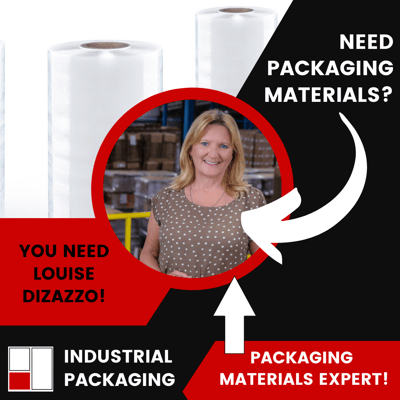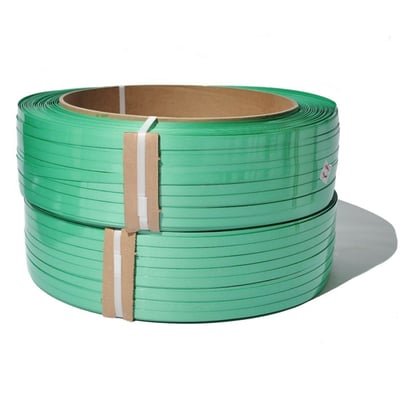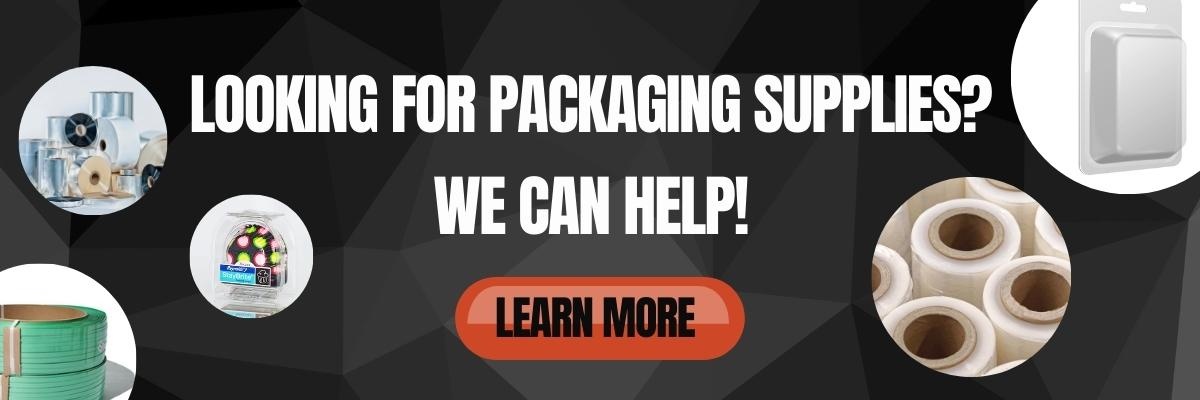What Are The Different Types Of Packaging Materials?
Are you entering the world of product packaging? If so, there are many items to consider and educate yourself on. One of the essential things to consider during this time is choosing the right type of packaging materials.
When you are looking to package a product, you need to decide which type of material you want to use. But, what material should you choose? Plastic, metal, cardboard, paperboard, foil, shrink film, bio-plastics, boxes, clamshells, or something else?
Once you have explored your options, you can choose the best material(s) for your packaging needs. But, you need to understand which supplies are appropriate for your applications.
Industrial Packaging has been selling, running, and consulting on packaging materials for generations. We know the entire realm of packaging materials inside and out.
This article will show you some of the packaging materials currently available. We will help you understand each option. Then, you can make an educated decision on which material is suitable for your products.
We're going to dive into several different types of packaging materials below. Each section will detail what the packaging material is made of and when it's best to use.
Each type of material is linked to a more in-depth article. These articles will offer a deeper exploration of that particular type of material.
Corrugated Boxes
Corrugated boxes are a staple of the packaging industry. For generations, corrugated boxes have been a go-to packaging material. They are used for packaging tons of products on packaging lines worldwide.
Corrugated boxes are often purchased preformed into a traditional rectangular box shape. Then again, they may arrive in flat stacks, in which case, the boxes must be put together by hand.
Corrugated boxes are often used for packaging applications in tandem with case erectors. Case erectors are a type of packaging machinery. People use these machines to form flat cardboard into a traditional box shape. The boxes are then used for packaging and shipping products.
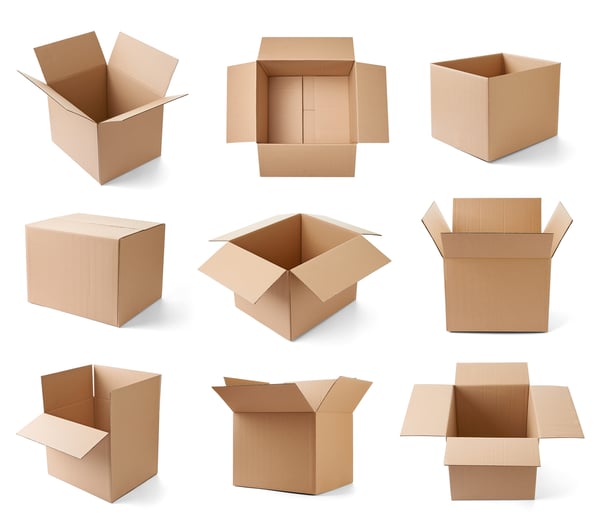
Corrugated boxes are made from (you guessed it) corrugated cardboard.
Corrugated cardboard is a packaging material made out of fiberboard. Generally speaking, corrugated cardboard is made from one or multiple types of fiberboard. Corrugated cardboard is created via a process called fluted lamination (AKA: corrugation).
Corrugated cardboard is sometimes referred to as corrugated fiberboard. Cardboard can technically be any heavy-duty paper-pulp-based boarding material.
Items commonly packaged in corrugated boxes include electronics, DVDs, consumer goods, and pre-packaged food items like cereal, chips, and cookies.
Stretch Film
Stretch film is one of the most common packaging materials in the world. Companies that have a shipping department are almost always using stretch film. They use it to contain their products on pallets before shipping.
This is done to protect products from collapse or damage during the shipping process. Stretch film achieves this goal with what is called "load containment."
Simply put, load containment allows your load to be adequately secured in place so that it can arrive safely to its destination.
There are various types of stretch wrap material currently available. Each one is made for specific applications. These types of film include:
- Machine Stretch
- Cast Stretch
- Blown Stretch
- Pre-Stretch
- Hay Baling Stretch
- Hand Stretch
- Color Stretch
- UVI Stretch
- VCI Stretch
- Vented Stretch
- Reinforced Stretch
- No Cling Stretch
Each of the above formulations of film is designed for specific applications. Each formulation should be used for the specified applications suggested. Using the wrong type of stretch film may result in inadequate load containment. Safety issues and poorly wrapped pallets may result from using the wrong film.
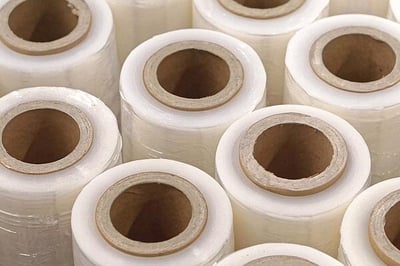
Stretch film is commonly used for the packaging and unitizing of multi-packs. These include multi-packs of toilet paper, paper towels, and bottled water.
Looking for packaging supplies? We can help!
Shrink Film
Shrink film is used on millions of packaging lines in companies all over the world. It is one of the most popular types of packaging materials currently on the market. It is used to package a mind-boggling array of products.
There are different types of shrink film formulations. The most common formulations are polyvinyl chloride (PVC), polyethylene (PE), and polyolefin (POF). Each formulation is designed for specific applications. For example, polyolefin is the best shrink film to wrap food with.
Using the wrong shrink film for the wrong products can result in poor packaging. It may also result in safety hazards and machinery problems.
Shrink film is used for packaging products in tandem with shrink tunnels and sealers. These are two types of packaging machinery that are required for running shrink film on your packaging line. The product is first run through the sealer, which places the product in a bag made of shrink film.
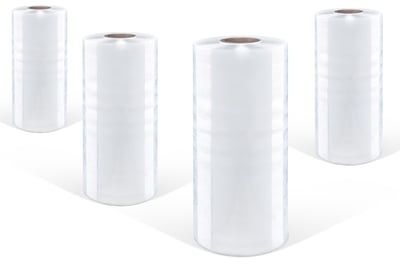
Each side of the bag is then sealed with heat. The product moves down the line into the shrink tunnel (also known as a heat tunnel). From there, the shrink film bag contracts uniformly around the product contained within.
Shrink film is commonly used to pack board games, frozen pizza boxes, and small consumer goods.
More Sustainable Shrink Film Alternatives
While currently available only in limited supply, biodegradable shrink films and recycled shrink films are presently available. For those of you who place significant importance on sustainability and earth-friendliness, these may be of interest to you.
It should be noted; these films are usually significantly more expensive and, due to supply chain issues, may be hard to acquire consistently. Some of these films may also require minimum order requirements.
Printed Shrink Film
The two primary forms of printed shrink film include polyolefin (or POF) shrink film and polyethylene shrink film. Polyethylene (or PE) shrink film is most commonly sold by shrink film manufacturers (also known as OEMs) and is generally thicker than polyolefin films.
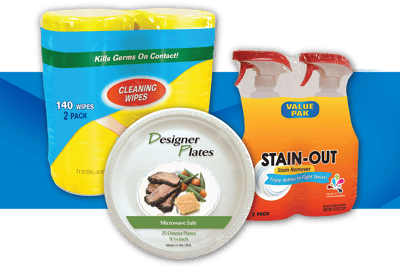
Essentially, printed films are almost identical to traditional transparent shrink films. But, with one caveat. In contrast to clear shrink film, printed film has the unique ability to print branded aesthetics and eye-catching graphics directly onto the film itself. Unlike clear shrink films, printed polyolefin film does not require labels.
Printed shrink films are most commonly used by high-volume CPG companies and provide a unique material for these types of businesses. It should be noted, all printed shrink films have a minimum order requirement.
As such, they are not usually a good fit for low-volume applications. On average, the minimum order requirement for printed shrink film is about 50,000 impressions. An impression is the length of film required to wrap a single bundle.
While printed shrink films are generally more expensive than traditional transparent shrink films, some light-gauge printed films are more affordable while being just as magnificent as their thicker counterparts.
Shrink Film Tubing
Shrink film tubing is a type of flat plastic tubing material that is rolled onto a core. Shrink film tubing is commonly cut into single sheets called shrink sleeves. These sleeves are used for packaging many different kinds of products.
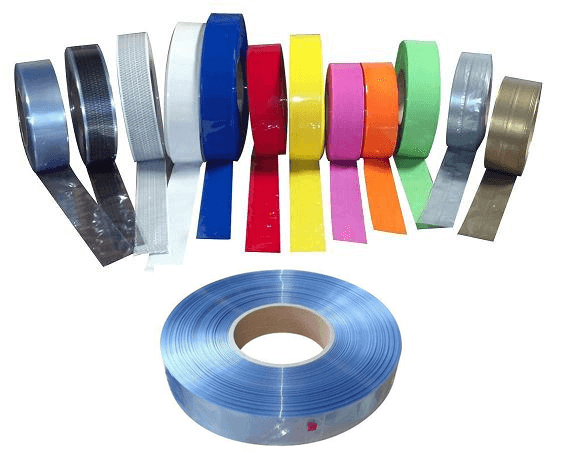
Shrink film tubing (AKA "heat seal" tubing, poly-tubing, or high-speed tubing) is made out of several different plastic formulations. This tubing material is commonly utilized for packaging various kinds of consumer goods. These may include glass bottles, fishing polls, metal rods, and other products.
Shrink film tubing is available in custom and standard sizes. Like printed shrink film, shrink film tubing may be printed with graphics, images, typography, and other branding elements.
Polybags
For the most part, polybags are clear or transparent bags made of plastic most commonly used for packaging and shipping specific consumer products. Generally speaking, poly bags are made from polyethylene, one of the most popular types of plastic packaging formulations today.

Polybags average a thickness of 1-6 mils. But, there are unique poly bags available that come in other thicknesses, both thinner and thicker. Some specialty plastic formulations are also available upon request. Polybags are popular due to their slim body shape, smooth hand-feel, reflectivity, and great flexibility.
Polybags are most commonly utilized in packaging applications for different consumer products, including t-shirts, industry magazines, various mailers, bed sheets, pillows, and many other goods.
Roll Bags
Roll bags are a type of transparent or printed flexible bagging that is made from several different plastic formulations. These bags are pre-rolled onto a plastic core and come on a roll. Every bag has an open side for easy product insertion and an opposite perforated end, allowing for the simple removal of each bag from the roll.

Roll bagging is similar to the bags that you will commonly find hanging from a roll at the grocery store for the bagging of produce. Although roll bags are most popular in the eCommerce market, they are also used extensively for paper mailers and certain types of medical products.
Bundling Film
Bundling film is a type of shrink film. This type of film is commonly used to form multi-packs of products. Multi-packs are also known as bundles. A multi-pack can include free-standing items or sit on top of a platform or sheet of material.
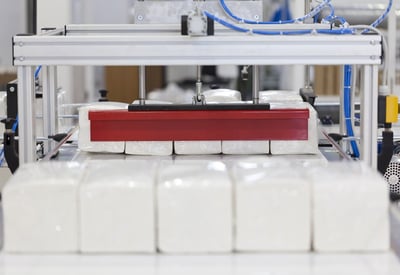
The bundle is cloaked inside shrink film (most commonly LDPE) and moved through a heat tunnel. The bundle is then packed together by the shrinking of the film, which holds the bundle together. Items that are packaged like this include products such as packs of water bottles or boxes of tissues.
Shrink Bands
Shrink bands (also known as seal bands) are a kind of protective packaging. These bands are often perforated for ease of use. Shrink bands are pre-made to fit the cap of different types of products. These products include bottles, jars, liquid droppers, and other similar items.
So how is a shrink band applied? A ring made out of soft plastic is put on the container's cap that needs to be sealed. Next, heat is used to make the ring shrink in a uniform way around the lid. This heat can be applied by a heat gun, shrink tunnel, or steam tunnel.
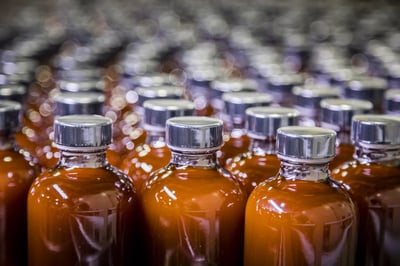
Shrink bands are like other tamper-evident packaging materials. They will let the consumer know if their product has been exposed to damage or tampering. They help protect consumers from consuming unsafe items.
Shrink bands provide extra strength for the seal of the product cap. This means the seal of the product is enhanced with additional protective qualities.
Flexible Pouches
Flexible pouches are generally made of foil or plastic (although they can be made of other materials). They are used in packaging for various applications. These applications include food and beverage packaging, as well as industrial liquid packaging. They can be found on shelves in supermarkets and other retail stores.
Flexible pouches have become extremely popular over the past few years for food packaging. This is because most of these pouches are resealable. They have a low environmental impact and are less costly to produce than alternative packaging materials such as glass, paperboard, metal, and cardboard.
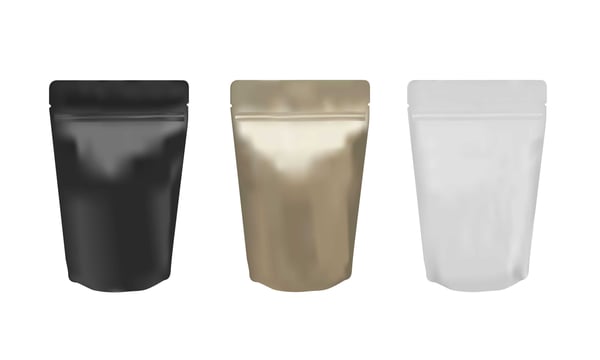
Flexible pouches are commonly used for packaging products like granola, energy drinks, coffee, soups, snacks, nuts, and many other types of food products.
The industrial hemp market has recently adopted flexible pouches. They are commonly used as packaging for cannabis and hemp products such as gummies, whole flower hemp, and other edible products.
Strapping
Strapping materials are used primarily for bundling products together and securing pallet loads during transport and storage. When used for palletizing, it is often complemented with the additional security of stretch wrap.
There are several different types of strapping material formulations, including polypropylene (PP), polyester (PET), and steel. The applications appropriate for strapping is dependent upon the required formulation. For example, typical applications for polypropylene include:
- Newspapers
- Magazines
- Direct mailers
- Moldings
- Banisters
- Hardwood Flooring
- Kitchen Appliances
- Clothing
- Food
- Hay bails
Carded Packaging
Carded packaging is a family of packaging supplies that includes three subcategories: skin, blister, and clamshell packaging. These materials are widely used across the world for a vast array of products.
From fishing lures to tools, from OTC pharmaceuticals to craft supplies, the applications for these packaging types are virtually endless. Still, each of them has its own subtle differences and uses.
Let's take a closer look at each type of carded packaging currently available and discover the differences and applications for each style.
Skin Packaging
Skin packaging or "skin packs" are a form of carded packaging materials that fully encases the product contained on a piece of skin-board. A thin sheet of either skin poly or surlyn film covers the product and is usually vacuum sealed to the skin board.
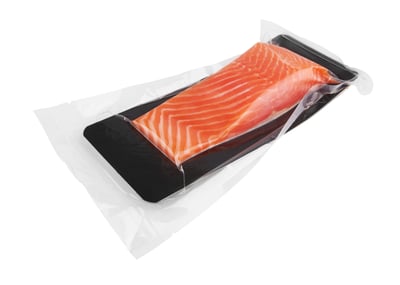
Skin packaging may seem similar to blister packaging, but with skin packs, the film takes the product's shape instead of being placed into a universal or standard-shaped container.
Products typically sold in skin packs may include seafood, pork, poultry, bison, hand tools, hardware, and other consumer goods.
Packaging Films For Skin Packaging
For skin packaging, there are two main types of plastic films used for these applications. These films include surlyn and skin poly film.
Surlyn
Dupont™ makes Surlyn® skin films. They are an aesthetically pleasing, light alternative to clamshells or blister packs. Surlyn® is used to vacuum pack products on coated skin boards when super high clarity and strength are required. Surlyn is commonly used for food packaging.
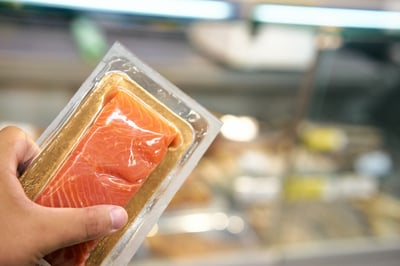
Skin Poly Film
Skin poly film is another skin film most commonly used in the formation of skin packaging. Skin poly is used for the same applications as surlyn. Skin poly is used in place of surlyn when the application requires a low-density polyethylene (LDPE) plastic formulation.
For applications that require both high clarity and strength, surlyn is the superior choice since it offers both features in a single film.
Blister Packaging
Blister Pack is the term used to describe multiple types of preformed plastic containers with blister-board backers commonly used for packaging products such as chewing gum, fishing lures, and OTC pharmaceuticals.
The main portion of a blister pack is a thermoformed container made from various plastic formulations. A backer of paperboard, foil, or plastic is attached to the back of the container. The backer is utilized to seal the products inside of the container.
Blister packaging is an outstanding choice for protecting products from damage, moisture, and contamination for extended periods.
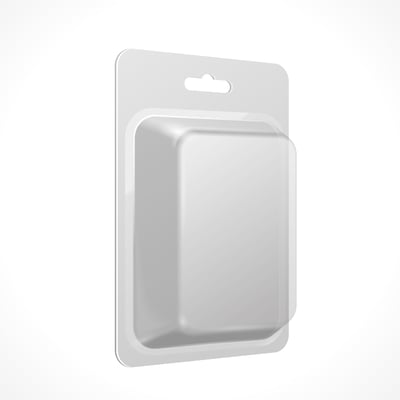
Products commonly found inside blister packs include fishing supplies, art and craft materials, toys, and other small consumer products. If you have batteries in your house, they are likely packaged inside of a well-branded blister pack with a paperboard backer.
Clamshells
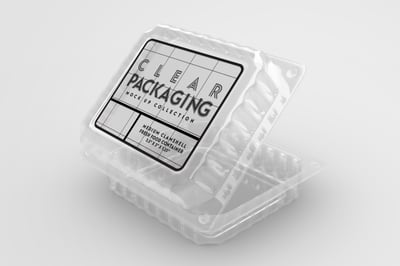
Clamshells are another type of carded packaging. Most clamshells are made from plastic. However, they are sometimes made from styrofoam, cardboard, recycled paper, or paperboard.
Clamshells are made by applying two identical "shells" together. These plastic shells are connected on one side and feature interlocking tabs on the other side. The tabs allow for easy opening and resealing capabilities.
Common applications for clamshell packaging includes grab-n-go items, grinders, breakfast sandwiches, salads, chicken wings, and other similar items.
Are There Any Other Types Of Packaging Supplies Available?
The list above contains many of the most popular types of packaging materials and includes some kinds of packaging supplies from both flexible packaging and rigid packaging options. Despite the length of the list above, it still only represents a fraction of the packaging materials currently available. A few other packaging supplies worth mentioning include:
While only featuring a selection of the most popular packaging materials, the packaging supplies listed in this article should provide you with enough information to start formulating an idea about the type of packaging materials that would work best for your product packaging requirements.
How To Choose The Proper Packaging Materials
Now that you understand the different types of packaging materials, the next step is to determine the materials that are best suited to packaging your products. To do that, check out this companion article, Which Packaging Supplies Are Right For Your Products? It will give you everything you need to understand to choose the appropriate packaging materials.
On the other hand, If you prefer to get some professional guidance in choosing suitable packaging materials for your products, you will want to consider speaking to one of our packaging experts. They will help you select the right packaging materials and vendor, even if that vendor is not ultimately us.
About Nathan Dube
As the Digital Marketing Specialist at Industrial Packaging, I am honored to create content for such a phenomenal company and work with one of the greatest teams in the Packaging Industry. Whether creating a video, writing blog posts or generating other pieces of content and multimedia, I am always excited to help educate and inspire our prospects and clients to reach their highest potential in regards to their packaging processes and needs.




